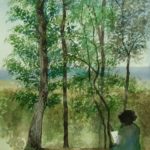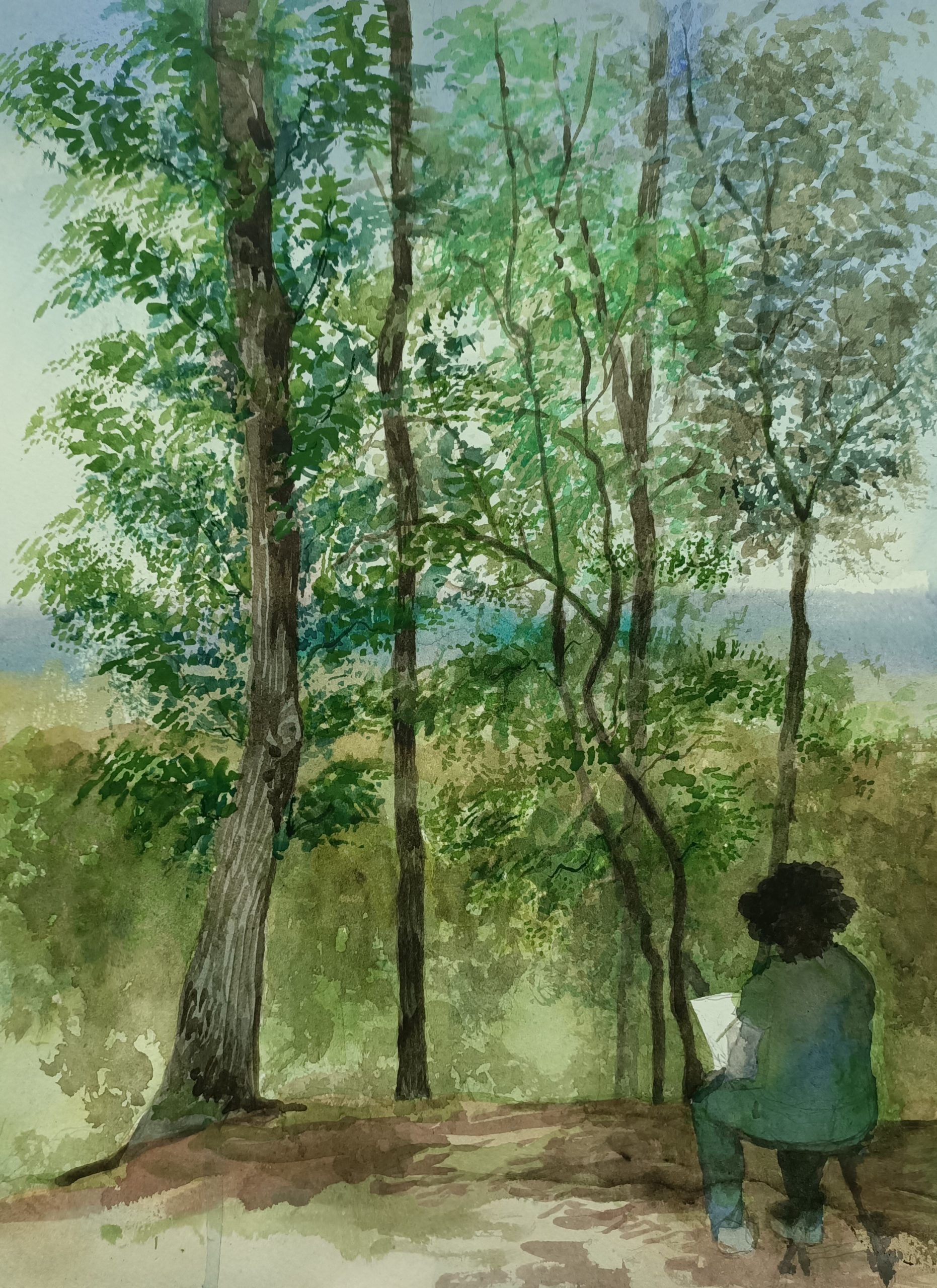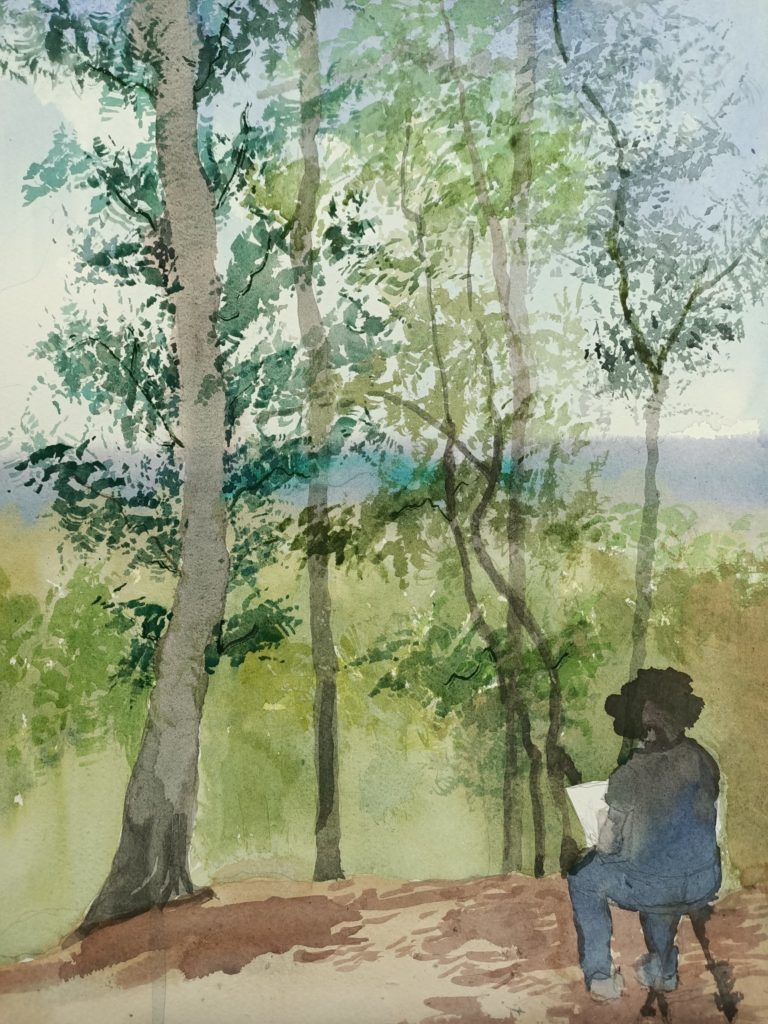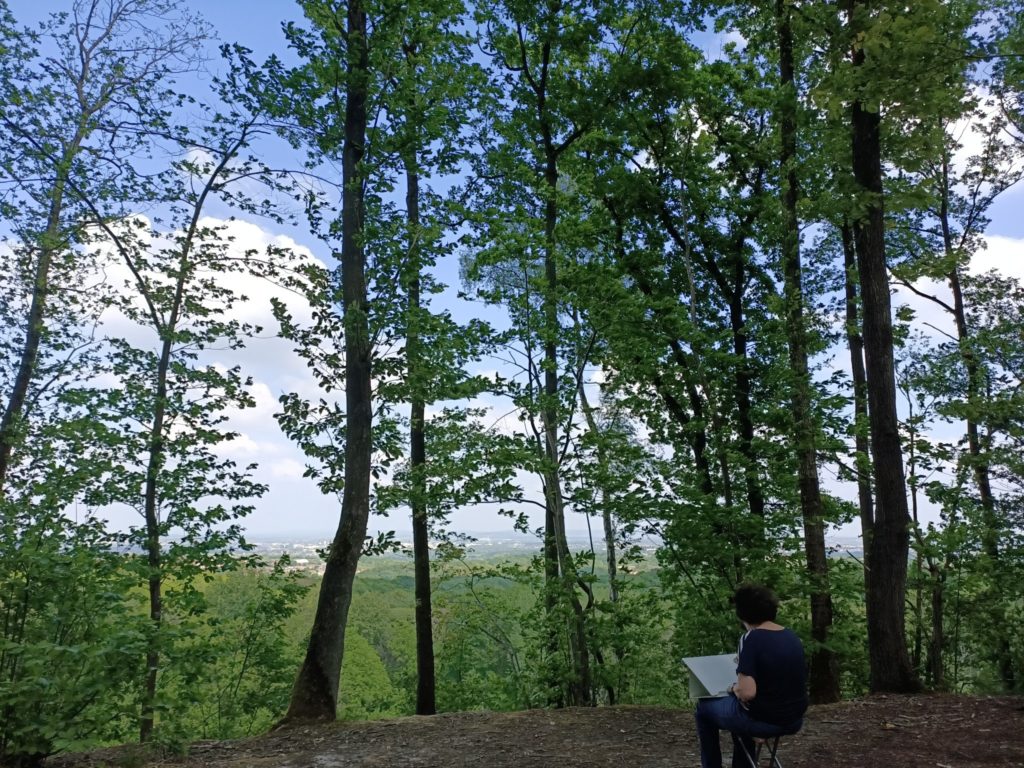Étiquette : horizon
Van Eyck, a Flemish Painter using Arab Optics?

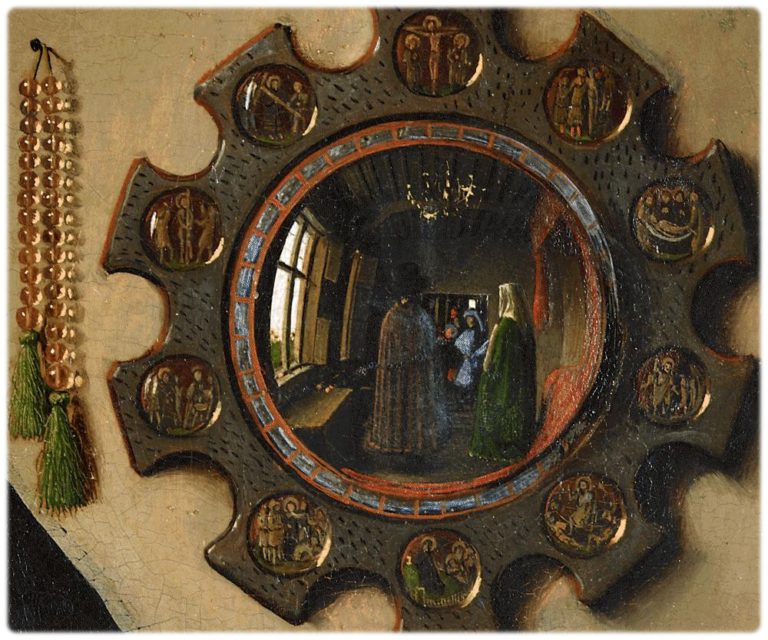
What follows is an edited transcript of a lecture by Karel Vereycken on the subject of “Perspective in XVth-century Flemish religious painting”.
It was delivered at the international colloquium “La recherche du divin à travers l’espace géométrique” (The quest for the divine through geometrical space) at the Paris Sorbonne University on April 26-28, 2006, under the direction of Luc Bergmans, Department of Dutch Studies (Paris IV Sorbonne University).
Introduction
« Perspective in XVth-century Flemish religious painting ». At first glance, this title may seem surprising. While the genius of fifteenth-century Flemish painters is universally attributed to their mastery of drying oil and their intricate sense of detail, their spatial geometry as such is usually identified as the very counter-example of the “right perspective”.
Disdained by Michelangelo and his faithful friend Vasari, the Flemish « primitives » would never have overcome the medieval, archaic and empirical model. For the classical “narritive”, still in force today, stipulates that only « Renaissance » perspective, obeying the canon of « linear », “mathematical” perspective, is the only « right », and the “scientific” one.
According to the same narrative, it was the research carried out around 1415-20 by the Duomo architect Filippo Brunelleschi (1377-1446), superficially mentioned by Antonio Tuccio di Manetti some 60 years later, which supposedly enabled Leon Battista Alberti (1404-1472), proclaiming himself Brunelleschi’s intellectual heir, to invent « perspective ».

In 1435, in De Pictura, a book entirely devoid of graphic illustration, Alberti is said to have formulated the premises of a perspectivist canon capable of representing, or at least conforming to, our modern notions of Cartesian space-time (NOTE 1), a space-time characterized as « entirely rational, i.e. infinite, continuous and homogeneous », « in one word, a purely mathematical space [dixit Panofsky] » (NOTE 2)
Long afterwards, in a drawing from the Codex Madrid, Leonardo da Vinci (1452-1519) attempted to unravel the workings of this model.
But in the same manuscript, he rigorously demonstrated the inherent limitations of the Albertian Renaissance perspectivist canon.
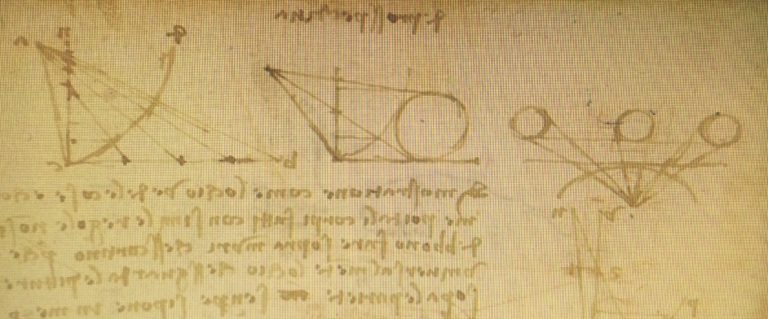
The drawing on f°15, v° clearly shows that the simple projection of visual pyramid cross-sections on a plane paradoxically causes their size to increase the further they are from the point of vision, whereas reality would require exactly the opposite. (NOTE 3)
With this in mind, Leonardo began to question the mobility of the eye and the curvilinear nature of the retina. Refusing to immobilize the viewer on an exclusive point of vision (NOTE 4), Leonardo used curvilinear constructions to correct these lateral deformations. (NOTE 5) In France, Jean Fouquet and others worked along the same lines.
But Leonardo’s powerful arguments were ignored, and he was unable to prevent this rewriting of history.
Despite this official version of art history, it should be noted that at the time, Flemish painters were elevated to pinnacles by Italy’s greatest patrons and art connoisseurs, specifically for their ability to represent space.
Bartolomeo Fazio, around the middle of the 15th century, observed that the paintings of Jan van Eyck, an artist billed as the « principal painter of our time », showed « tiny figures of men, mountains, groves, villages and castles rendered with such skill that one would think them fifty thousand paces apart. » (NOTE 6)
Such was their reputation that some of the great names in Italian painting had no qualms about reproducing Flemish works identically. I’m thinking, for example, of the copy of Hans Memlinc‘s Christ Crowned with Thorns at the Genoa Museum, copied by Domenico Ghirlandajo (Philadelphia Museum).
But post-Michelangelo classicism deemed the non-conformity of Flemish spatial geometry with Descartes’ « extended substance » to be an unforgivable crime, and any deviation from, or insubordination to, the « Renaissance » perspectivist canon relegated them to the category of « primitives », i.e. « empiricists », clearly devoid of any scientific culture.
Today, ironically, it is almost exclusively those artists who explicitly renounce all forms of perspectivist construction in favor of pseudo-naïveté, who earn the label of modernity…

In any case, current prejudices mean that 15th-century Flemish painting is still accused of having ignored perspective.
It’s true, however, that at the end of the XIVth century, certain paintings by Melchior Broederlam (c. 1355-1411) and others by Robert Campin (1375-1444) (Master of Flémalle) show the viewer interiors where plates and cutlery on tables threaten to suddenly slide to the floor.
Nevertheless, it must be admitted that whenever the artist « ignores » or disregards the linear perspective scheme, he seems to do so more by choice than by incapacity. To achieve a limpid composition, the painter prioritizes his didactic mission to the detriment of all other considerations.
For example, in Campin’s Mérode Altarpiece, the exaggerated perspective of the table clearly shows that the vase is behind the candlestick and book.
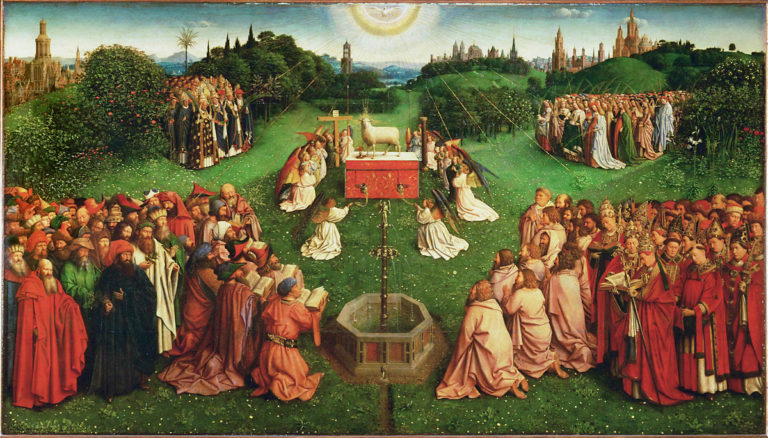
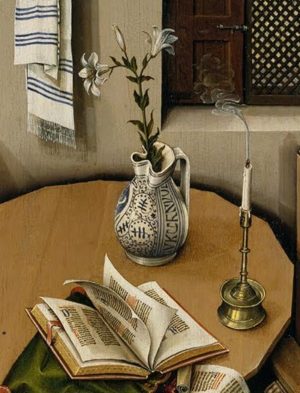
Jan van Eyck’s Lam Gods (Mystic Lamb) in Ghent is another example.
Never could so many figures, with so much detail and presence, be shown with a linear perspective where the figures in the foreground would hide those behind. (NOTE 7)
But the intention to approximate a credible sense of space and depth remains.
If this perspective seems flawed by its linear geometry, Campin imposes an extraordinary sense of space through his revolutionary treatment of shadows. As every painter knows, light is painted by painting shadow.
In Campin’s work, every object and figure is exposed to several sources of light, generating a darker central shadow as the fruit of crossed shadows.
Van Eyck influenced by Arab Optics?
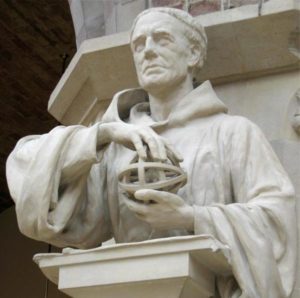
Roger Bacon, statue in Oxord.
This new treatment of light-space has been largely ignored. However, there are several indications that this new conception was partly the result of the influence of « Arab » science, in particular its work on optics.
Translated into Latin and studied from the XIIth century onwards, their work was developed in particular by a network of Franciscans whose epicenter was in Oxford (Robert Grosseteste, Roger Bacon, etc.) and whose influence spread to Chartres, Paris, Cologne and the rest of Europe.
It should be noted that Jan van Eyck (1395-1441), an emblematic figure of Flemish painting, was ambassador to Paris, Prague, Portugal and England.
I’ll briefly mention three elements that support this hypothesis of the influence of Arab science.

Curved mirrors
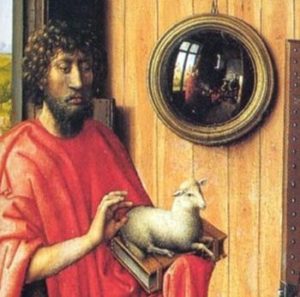
Robert Campin (master of Flémalle) in the Werl Triptych (1438) and Jan van Eyck in the Arnolfini portrait (1434), each feature convex mirrors of considerable size.
It is now certain that glaziers and mirror-makers were full members of the Saint Luc guild, the painters’ guild. (NOTE 8)
But it is relevant to know that Campin, now recognized as having run the workshop in Tournai where the painters Van der Weyden and Jacques Daret were trained, produced paintings for the Franciscans in this city. Heinrich Werl, who commissioned the altarpiece featuring the convex mirror, was an eminent Franciscan theologian who taught at the University of Cologne.

Artistic representation of Ibn Al-Haytam (Alhazen)
These convex and concave (or ardent) mirrors were much studied during the Arab renaissance of the IXth to XIth centuries, in particular by the Arab philosopher Al-Kindi (801-873) in Baghdad at the time of Charlemagne.
Arab scientists were not only in possession of the main body of Hellenic work on optics (Euclid‘s Optics, Ptolemy‘s Optics, the works of Heron of Alexandria, Anthemius of Tralles, etc.), but it was sometimes the rigorous refutation of this heritage that was to give science its wings.
After the decisive work of Ibn Sahl (Xth century), it was that of Ibn Al-Haytam (Latin name : Alhazen) (NOTE 9) on the nature of light, lenses and spherical mirrors that was to have a major influence. (NOTE 10)
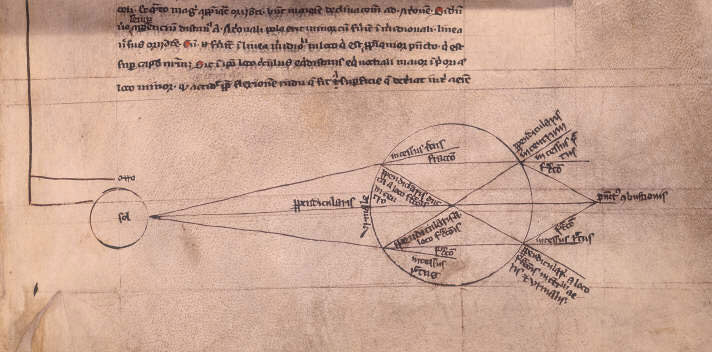
As mentioned above, these studies were taken up by the Oxford Franciscans, starting with the English bishop of Lincoln, Robert Grosseteste (1168-1253).
In De Natura Locorum, for example, Grosseteste shows a diagram of the refraction of light in a spherical glass filled with water. And in his De Iride he marvels at this science which he connexts to perspective :
« This part of optics, so well understood, shows us how to make very distant things appear as if they were situated very near, and how we can make small things situated at a distance appear to the size we desire, so that it becomes possible for us to read the smallest letters from incredible distances, or to count sand, or grains, or any small object.«
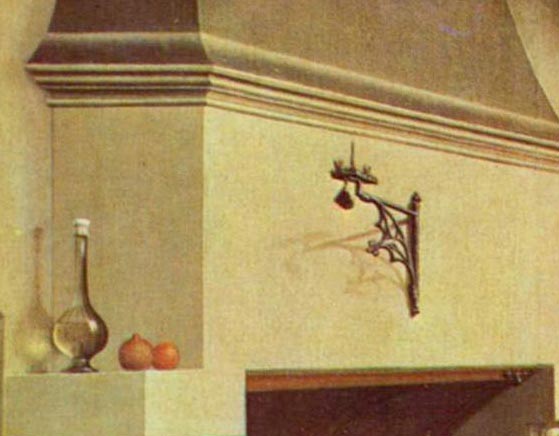
Grosseteste’s pupil Roger Bacon (1212-1292) wrote De Speculis Comburentibus, a specific treatise on « Ardent Mirrors » which elaborates on Ibn Al-Haytam‘s work.
Flemish painters Campin, Van Eyck and Van der Weyden proudly display their knowledge of this new scientific and technological revolution metamorphosed into Christian symbolisms.
Their paintings feature not only curved mirrors but also glass bottles, which they use as a metaphor for the immaculate conception.
A Nativity hymn of that period says:
« As through glass the ray passed without breaking it, so of the Virgin Mother, Virgin she was and virgin she remained… » (NOTE 11)
The Treatment of Light
In his Discourse on Light, Ibn Al-Haytam develops his theory of light propagation in extremely poetic language, setting out requirements that remind us of the « Eyckian revolution ». Indeed, Flemish « realism » and perspective are the result of a new treatment of light and color.
Ibn Al-Haytam:
« The light emitted by a luminous body by itself -substantial light- and the light emitted by an illuminated body -accidental light- propagate on the bodies surrounding them. Opaque bodies can be illuminated and then in turn emit light. »
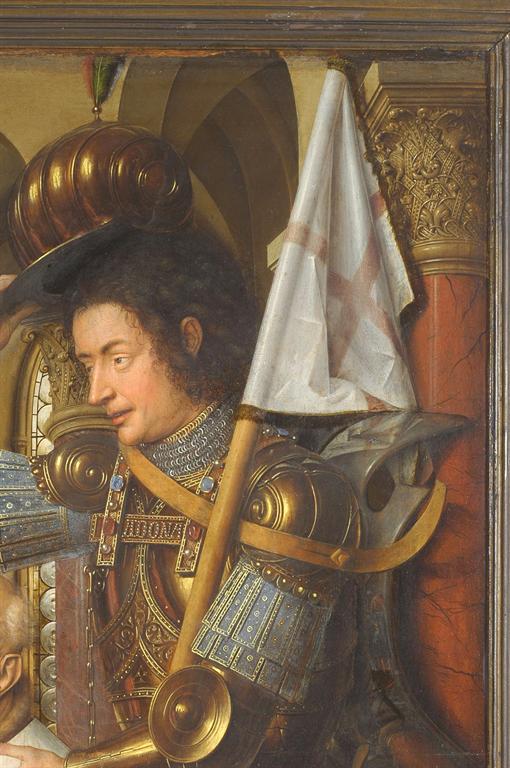
This physical principle, theorized by Leonardo da Vinci, is omnipresent in Flemish painting. Just look at the images reflected in the helmet of St. George in Van Eyck‘s Madonna to Canon van der Paele (NOTE 12).
In each curved surface of Saint George’s helmet, we can identify the reflection of the Virgin and even a window through which light enters the painting.
The shining shield on St. George’s back reflects the base of the adjacent column, and the painter’s portrait appears as a signature. Only a knowledge of the optics of curved surfaces can explain this rendering.
Ibn Al-Haytam:
« Light can penetrate transparent bodies: water, air, crystal and their counterparts. »
And :
« Transparent bodies have, like opaque bodies, a ‘receiving power’ for light, but transparent bodies also have a ‘transmitting power’ for light.«
Isn’t the development of oil mediums and glazes by the Flemish an echo of this research? Alternating opaque and translucent layers on very smooth panels, the specificity of the oil medium alters the angle of light refraction.
In 1559, the painter-poet Lucas d’Heere referred to van Eyck‘s paintings as « mirrors, not painted scenes.«
Binocular perspective
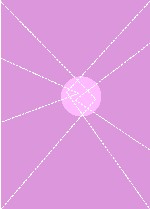
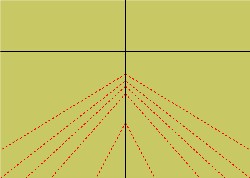

Before the advent of « right » central linear perspective, art historians sought a coherent explanation for its birth in the presence of several seemingly disparate vanishing points by theorizing a so-called central « fishbone » perspective.
In this model, a number of vanishing lines, instead of coinciding in a single central vanishing point on the horizon, either end up in a « vanishing region » (NOTE 13), or align with what some call a vertical « vanishing axis », forming a kind of « fishbone ».
French Professor Dominique Raynaud, who worked for years on this issue, underscores that « all medieval treatises on perspective address the question of binocular vision », notably the Polish scholar Witelo (1230-1280) (NOTE 15) in his Perspectiva (I,27), an insight he also got from the works of Ibn Al-Haytam.
Witelo presents a figure to defend the idea that
« the two forms, which penetrate two homologous points of the surface of the two eyes, arrive at the same point of the concavity of the common nerve, and are superimposed at this point to become one » (Perspectiva, III, 37).
A similar line of reasoning can be found in Roger Bacon‘s Perspectiva Communis, written by John Pecham, Archbishop of Canterbury (1240-1290) for whom:
« the duality of the eyes must be reduced to unity »
So, as Professor Raynaud proposed, if we extend the famous vanishing lines (i.e., in our case, the « fish bones ») until they intersect, the « vanishing axis » problem disappears, as the vanishing lines meet. Interestingly, the result is a perspective with two vanishing points in the central region!
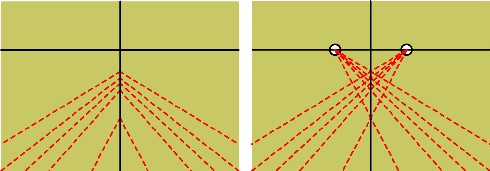
Suddenly, the diagrams drawn up to demonstrate the « empiricism » of the Flemish painters, if viewed from this point of view, reveal a legitimate construction probably based on optics as transmitted by Arab science and rediscovered by Franciscan networks and others.
Two paintings by Jan van Eyck clearly demonstrate that he followed this approach: The Madonna with Canon van der Paele of 1436 and the Dresden Tryptic of 1437.
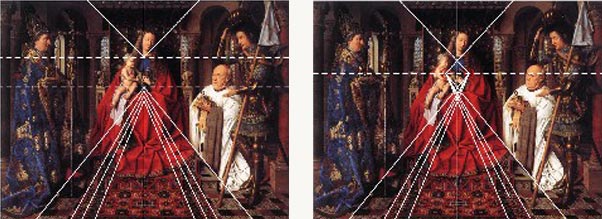

What seemed a clumsy, empirical approach in the form of a « fishbone » perspective (left) turns out to be a binocular perspective construction.
Was this type of perspective specifically Flemish?
A close examination of works by Ghiberti, Donatello and Paolo Uccello, generally dating from the first half of the XVth Century, reveals a mastery of the same principle.
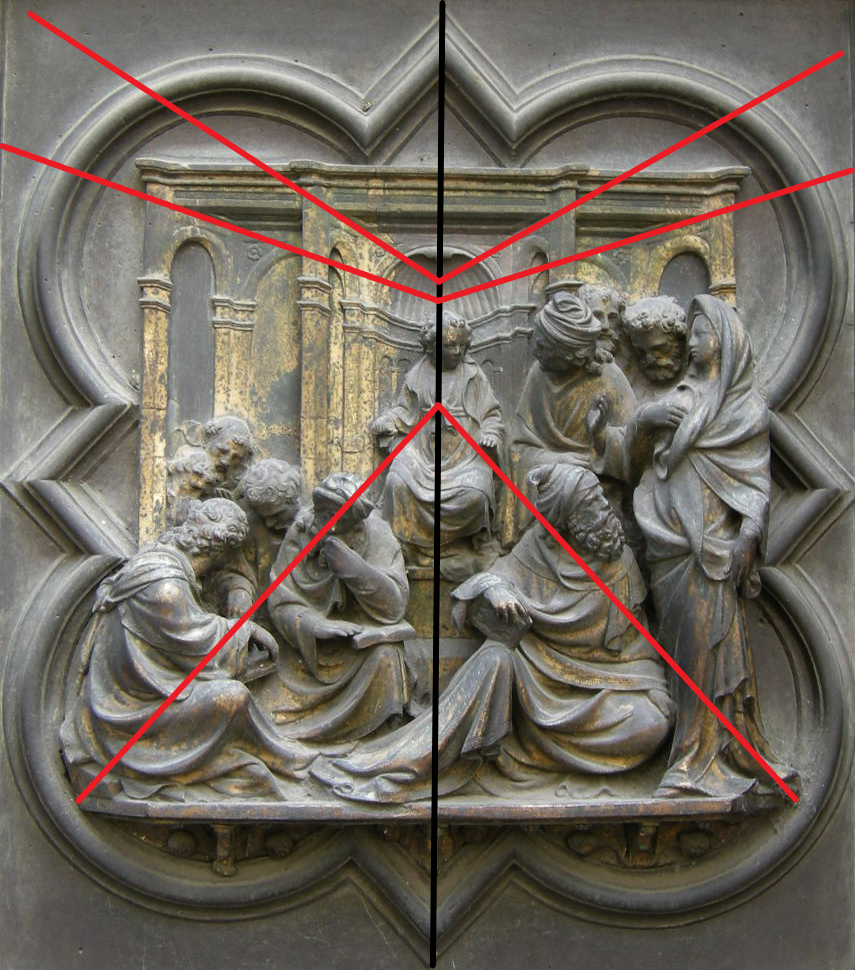

Cusanus
But this whole demonstration is merely a look into the past through the eyes of modern scientific rationality. It would be a grave error not to take into account the immense influence of the Rhenish (Master Eckhart, Johannes Tauler, Heinrich Suso) and Flemish (Hadewijch of Antwerp, Jan van Ruusbroec, etc.) « mystics ».
This trend began to flourish again with the rediscovery of the Christianized neo-Platonism of Dionysius the Areopagite (Vth-VIth century), made accessible… by the new translations of the Franciscan Grosseteste in Oxford.
The spiritual vision of the Aeropagite, expressed in a powerful imagery language, is directly reminiscent of the metaphorical approach of the Flemish painters, for whom a certain type of light is simply the revelation of divine grace.
In On the Heavenly Hierarchy, Dionysius immediately presents light as a manifestation of divine goodness. It ennobles us and enables us to enlighten others:
« Let those who are illuminated be filled with divine clarity, and the eyes of their understanding trained to the work of chaste contemplation; finally, let those who are perfected, once their primitive imperfection has been abolished, share in the sanctifying science of the marvelous teachings that have already been manifested to them; similarly, let the purifier excel in the purity he communicates to others; let the illuminator, gifted with a greater penetration of spirit, equally fit to receive and transmit light, happily flooded with sacred splendor, pour it out in pressing streams on those who are worthy… » [Chap. III, 3]
Let’s think again of the St. George in Van Eyck‘s Madonna to Canon van der Paele, which indeed pours forth the multiple images of the Virgin who enlightens him.
This theo-philosophical trend reached full maturity in the work of Cardinal Nicolas of Cusa (Cusanus) (1401-1464) (NOTE 16), embodying the extremely fruitful encounter of this « negative theology » with Greek science, Socratic knowledge and Christian Humanism.

In contrast to both a science « without a hypothesis of God » and a metaphysics with an esoteric drift, an agapic love leads it to the education of the greatest number, to the defense of the weak and the humiliated.
The Brothers and Sisters of the Common Life, educating Erasmus of Rotterdam and inspiring Cusanus, are the best example of this.
But let’s sketch out some of Cusanus’ key ideas on painting.
In De Icona (The Vision of God) (1453), which he sent to the Benedictine monks of the Tegernsee, Cusanus condenses his fundamental work On Learned Ignorance (1440), in which he develops the concept of the coincidence of opposites. His starting point was a self-portrait of his friend « Roger », the Flemish painter Rogier van der Weyden, which he sent together with his sermon to the monks.
This self-portrait, like the multiple faces of Christ painted in the XVth century, uses an « optical illusion » to create the effect of a gaze that fixes the viewer, regardless of his or her position in front of the altarpiece.
In De Icona, written as a sermon, Cusanus asks monks to stand in a semicircle around the painting and watch this gaze pursue them as they move along the segment of the curve. In fact, he elaborates a pedagogical paradox based on the fact that the Greek name for God, Theos, has its etymological origin in the verb theastai (to see, to look at).
As you can see, he says, God looks at you personally, and his gaze follows you everywhere. He is therefore one and many. And even when you turn away from him, his gaze falls on you. So, miraculously, although he looks at everyone at the same time, he nevertheless establishes a personal relationship with each one. If « seeing » for God is « loving », God’s point of vision is infinite, omniscient and omnipotent love.
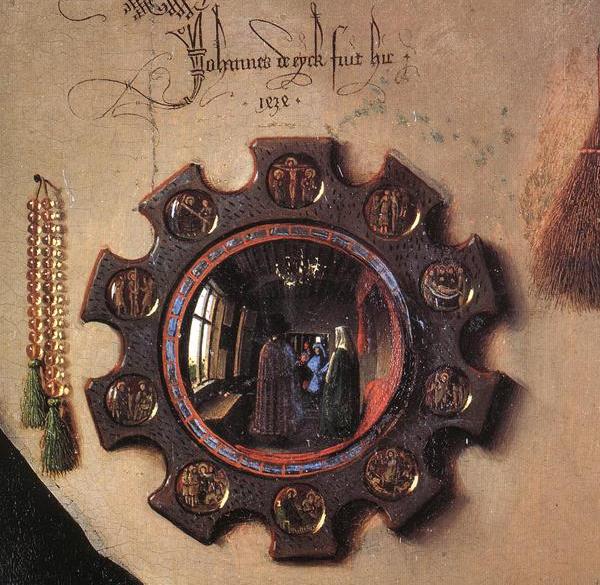
A parallel can be drawn here with the spherical mirror at the center of Jan van Eyck’s painting The Arnolfini portrait, painted in 1434, nineteen years before this sermon.
Firstly, this circular mirror is surrounded by the ten stations of Christ’s Passion, juxtaposed by a rosary, an explicit reference to God.
Secondly, it reveals a view of the entire room, an image that completely escapes the linear perspective of the foreground. A view comparable to the allcompassing « Vision of God » developed by Cusanus.
Finally, we see two figures in the mirror, but not the image of the painter behind his easel. These are undoubtedly the two witnesses to the wedding. Instead of signing his painting with « Van Eyck invent. », the painter signed his painting above the mirror with « Van Eyck was here » (NOTE 17), identifying himself as a witness.
As Dionysius the Aeropagite asserted:
« [the celestial hierarchy] transforms its adepts into so many images of God: pure and splendid mirrors where the eternal and ineffable light can shine, and which, according to the desired order, reflect liberally on inferior things this borrowed brightness with which they shine. » [Chap. III, 2]
The Flemish mystic Jan van Ruusbroec (1293-1381) evokes a very similar image in his Spiegel der eeuwigher salicheit (Mirror of eternal salvation) when he says:
« Ende Hi heeft ieghewelcs mensche ziele gescapen alse eenen levenden spieghel, daer Hi dat Beelde sijnre natueren in gedruct heeft. » (And he created each human soul as a living mirror, in which he imprinted the image of his nature).
And so, like a polished mirror, Van Eyck’s soul, illuminated and living in God’s truth, acts as an illuminating witness to this union. (NOTE 18)
So, although the Flemish painters of the XVth century clearly had a solid scientific foundation, they choose such or such perspective depending on the idea they wanted to convey.
In essence, their paintings remain objects of theo-philosophical speculation or as you like « intellectual prayer », capable of praising the goodness, beauty and magnificence of a Creator who created them in His own image. By the very nature of their approach, their interest lay above all in the geometry of a kind of « paradoxical space-light » capable, through enigma, of opening us up to a participatory transcendence, rather than simply seeking to « represent » a dead space existing outside metaphysical reality.
The only geometry worthy of interest was that which showed itself capable of articulating this non-linearity, a « divine » or « mystical » perspective capable of linking the infinite beauty of our commensurable microcosm with the immeasurable goodness of the macrocosm.
Thank you,
NOTES:
- Recently, Italian scholars have pointed to the role of Biagio Pelacani Da Parma (d. 1416), a professor at the University of Padua near Venice, in imposing such a perspective, which privileged only the « geometrical laws of the act of vision and the rules of mathematical calculation ».
- Erwin Panofsky, Perspective as Symbolic Form, p.41-42, Les Éditions de Minuit, Paris, 1975.
- Institut de France, Manuscrit E, 16 v° « the eye [h] perceives on the plane wall the images of distant objects greater than that of the nearer object. »
- Leonardo understands that Albertian perspective, like anamorphosis, condemns the viewer to a single, immobile point of vision.
- See, for example, the slight enlargement of the apostles at the ends of Leonardo da Vinci’s Last Supper in the Milan refectory.
- Baxandall, Bartholomaeus Facius on painting, Journal of the Warburg and Courtauld Institutes, 27, (1964). Fazio is also enthusiastic about a world map (now lost) by Jan van Eyck, in which all the places and regions of the earth are depicted recognizably and at measurable distances.
- To escape this fate, Pieter Bruegel the Elder used a cavalier perspective, placing his horizon line high up.
- Lionel Simonot, Etude expérimentale et modélisation de la diffusion de la lumière dans une couche de peinture colorée et translucide. Application à l’effet visuel des glacis et des vernis, p.9 (PhD thesis, Nov. 2002).
- Ibn Al-Haytam (Alhazen) (965-1039) wrote some 200 works on mathematics, astronomy, physics, medicine and philosophy. Born in Basra, after working on the development of the Nile in Egypt, he travelled to Spain. He is said to have carried out a series of highly detailed experiments on theoretical and experimental optics, including the camera obscura (darkroom), work that was later to feature in Leonardo da Vinci’s studies. Da Vinci may well have read the lengthy passages by Alhazen that appear in the Commentari of the Florentine sculptor Ghiberti. According to Gerbert d’Aurillac (the future Pope Sylvester II in 999), Bishop of Rheims, brought back from Spain the decimal system with its zero and an astrolabe, it was thanks to Gerard of Cremona (1114-c. 1187) that Europe gained access to Greek, Jewish and Arabic science. This scholar went to Toledo in 1175 to learn Arabic, and translated some 80 scientific works from Arabic into Latin, including Ptolemy’s Almagest, Apollonius’ Conics, several treatises by Aristotle, Avicenna‘s Canon, and the works of Ibn Al-Haytam, Al-Kindi, Thabit ibn Qurra and Al-Razi.
- In the Arab world, this research was taken up a century later by the Persian physicist Al-Farisi (1267-1319). He wrote an important commentary on Alhazen’s Treatise on Optics. Using a drop of water as a model, and based on Alhazen’s theory of double refraction in a sphere, he gave the first correct explanation of the rainbow. He even suggested the wave-like property of light, whereas Alhazen had studied light using solid balls in his reflection and refraction experiments. The question was now: does light propagate by undulation or by particle transport?
- Meiss, M., Light as form and symbol in some fifteenth century paintings, Art Bulletin, XVIII, 1936, p. 434.
- Note also the fact that the canon shows a pair of glasses…
- Brion-Guerry in Jean Pèlerin Viator, sa place dans l’histoire de la perspective, Belles Lettres, 1962, p. 94-96, states in obscure language that « the object of representation behaves most often in Van Eyck as a cubic volume seen from the front and from the inside. Perspectival foreshortening is achieved by constructing a rectangle whose sides form the base of four trapezoids. The orthogonals thus tend towards four distinct points of convergence, forming a ‘vanishing region' ».
- Dominique Raynaud, L’Hypothèse d’Oxford, essai sur les origines de la perpective, PUF, Paris 1998.
- Witelo was a friend of the Flemish Dominican scholar Willem van Moerbeke, a translator of Archimedes in contact with Saint Thomas Aquinas. Moerbeke was also in contact with the mathematician Jean Campanus and the Flemish neo-Platonic astronomer Hendrik Bate van Mechelen. Johannes Kepler‘s own work on human vision builds on that of Witelo.
- Cusanus was above all a man of science and theology. But he was also a political organizer. The painter Jan van Eyck fought for the same goals, as evidenced by the ecumenical theme of the Ghent polyptych. It shows the Mystic Lamb, symbolizing the sacrifice of the Son of God for the redemption of mankind, capable of reuniting a church torn apart by internal differences. Hence the presence of the three popes in the central panel, here united before the lamb. Van Eyck also painted a portrait of Cardinal Niccolo Albergati, one of the instigators of the great Ecumenical Council organized by Cusanus in Ferrara and then moved to Florence. If Cusanus called Van der Weyden « his friend Roger », it is also thought that Robert Campin may have met him, since he would have attended the Council of Basel, as did one of his commissioners, the Franciscan theologian Heinrich Werl.
- Jan Van Eyck was one of the first painters in the history of art to date and sign his paintings with his own name.
- Myriam Greilsammer’s book L’Envers du tableau, Mariage et Maternité en Flandre Médiévale (Editions Armand Colin, 1990) documents Arnolfini’s sexual escapades. Arnolfini was taken to court by one of his victims, a female servant. Van Eyck seems to have understood that the knightly Arnoult Fin, Lucchese financier and commercial representative of the House of Medici in Bruges, required the somewhat peculiar presence of the eye of the lord.
Léonard en résonance avec la peinture traditionnelle chinoise


Mon entretien avec le Quotidien du Peuple: (People’s Daily)
Version chinoise (mandarin) suivie de la version française (FR) et anglaise (EN):
2019年12月18日17:03 来源:人民网-国际频道 分享到:
人民网巴黎12月17日电(记者 葛文博)今年是达芬奇逝世500周年,长居法国的比利时版画家、艺术史学家、美术评论家雷尔·维希肯(Karel Vereycken)近日接受人民网记者采访,阐述其多年研究达芬奇绘画技法的心得,认为《蒙娜丽莎》一画同中国古代绘画技法异曲同工。
在他看来,许多人采用“欧洲中心”的视角将透视法归于西方独创和所有,这是错误的。维希肯通过观察中国古代尤其是宋代的绘画作品,提出中国才是透视法的先驱,后世包括达芬奇在内的许多欧洲艺术家的作品都能同中国古代绘画理论和技法产生共鸣。
人民网:您认为中国绘画如何启发了透视法?
维希肯:中国从公元6世纪开始,一些艺术著作不仅记录了文艺实践,也启发了更为活跃的绘画艺术。中国南北朝著名的画家、文艺理论家谢赫提出的“六法”,既要“气韵生动”又要“应物象形” 。宋代画家与书画鉴赏家郭若虚在其《图画见闻志》中写道:“人品既已高矣,气韵不得不高;气韵既已高矣,生动不得不至”。这显然超脱了绘画的“技术”层面,升华进入了精神和道德领域。它突破单纯形制而追求由内而外的生命力,成为透视法的重要理论基础。
人民网:这与达芬奇绘画技法有何契合之处?
维希肯:我在2007年发表的文章《达芬奇,捕捉运动的画家》中就指出,这位画家渴望绘制运动、转变的场景。达芬奇非常认同希腊哲学家赫拉克利特斯的名言“世上唯有‘变化’才是永恒的”。然而,要掌握的不是物体的形式或它们所处的时空,而是要掌握它们在变化过程中在给定时刻的外观,这就有必要深入了解产生变化的原因。
宋代苏轼在其《净因院画记》中提出,人类、家禽、宫殿、居室、器物、使用的东西,都有其经常所处的形态。至于山川、岩石、竹子、柴木,流水、海波、烟雾、云朵,虽没有经常所处的形态,但有其存在的本质。我发现,苏轼追求本质、重视变化的观念同达芬奇寻求运动的思路不谋而合。
唐代诗人王维在其《山水论》中更为详尽地阐述其对透视的理解:“远人无目,远树无枝。远山无石,隐隐如眉;远水无波,高与云齐”。 对画面的空间、层次、疏密、清晰度等做出细致描述。这与达芬奇采用的“空气透视法”也完全契合。
人民网:这种契合如何表现在达芬奇的《蒙娜丽莎》画作中?
韦雷肯:除了形体的运动以外,达芬奇还试图表达一种“非物质的运动”,他将其分为五类。第一个是时间,因为它“包容了所有其他事物”,其他分别还有光、声音和气味的传播。在他看来,这些并非实体的运动恰恰使事物充满生机。
但是,如何描绘这种生机呢?仅凭借固定的形式是不可能的,因为死死抓住形式不放,就如同费心捕捉美丽的蝴蝶却将其用钉子钉住制成标本,生命力就消逝了。雕塑家、诗人和画家必须在作品中制造讽刺、矛盾和模糊,就像伟大的思想家林登·拉鲁什(Lyndon LaRouche)所说的“中间状态”,以揭示潜在的运动和变化。
蒙娜丽莎的脸上就充满了神秘的“矛盾”:嘴巴的一侧微笑,另一侧微笑的程度略小;一只眼睛透出认真的眼神,另一只眼睛则透出愉悦;一只眼睛看着你,另一只眼睛则越过了你,等等。蒙娜丽莎的微笑难下定义,因为它恰好在“中间状态”。她是真的微笑还是哭泣?她的微笑能拥有这样迷人的力量,是因为她身后的风景更为迷人。这副画风景的透视更接近之前我们所述的中国画的规则,而不是彼时欧洲的死板规定。
在中国画中,水与山之间的相互作用是普遍转变的象征,可以将不同层次的山、水、雾等联系起来。从公元10世纪开始,中国画寻求与人类视觉经验相符的构造,不仅采用焦点透视,反而创造运用随着视线投射变化产生的散点透视。这种透视恰恰存在于达芬奇的《蒙娜丽莎》之中,在人物的左侧,视线位于鼻孔的高度,在人物右侧,水平线则升至眼角。这样打破常规的透视法,令我们感受到蒙娜丽莎鲜活的生命和活泼的灵魂,聆听着到画作与中国传统绘画穿越时空的共鸣。 (责编:李婷(实习生)、燕勐)
Cet article a été repris par les sites chinois suivants:
- People’s Daily: http://world.people.com.cn/n1/2019/1218/c1002-31512405.html
- Eastday.com: http://news.eastday.com/w/20191218/u1ai20237205.html
- Chinese Academy of Social Sciences (CASS): http://www.cssn.cn/hqxx/hqwx/hqwxnews/201912/t20191219_5061586.shtml
- art-ville.com: http://www.art-ville.com/zixun/vQBpc.html
- themusicalhacker.com: http://www.themusicalhacker.com/guoji/16.html
- beanstalky.com: http://www.beanstalky.com/guoji/14.html
- Foro-avdi.com: http://www.foro-avdi.com/guoji/2164.html
- Qz123.com : http://www.qz123.com/html/298/20191219/news_show_244384.html
- Myweb.wang: http://www.myweb.wang/news/details/bb529d5833e8650ab25f9220121a125e
- kknews.cc: https://kknews.cc/culture/y5l42og.html
- haxw.net: http://www.haxw.net/guoji/8377.html
- fjshuchi.com: https://www.fjshuchi.com/news/j8jhjdjlh9jmhl8.html
- xw.qq.com: https://xw.qq.com/cmsid/20191218A0KSC300
- news.66wz.com: http://news.66wz.com/system/2019/12/18/105218123.shtml
- zutiyu.com : http://www.zutiyu.com/content/20191219/4037144.htm
- mini.eastday.com: https://mini.eastday.com/a/191218172310279.html
- sapuc.ch: http://www.sapuc.ch/php/indexi_5.php
- dzwww.com: http://www.dzwww.com/xinwen/guojixinwen/201912/t20191218_19480201.htm
- m.regulatingsenses.com: http://m.regulatingsenses.com/guoji/6.html
- Zolix: http://www.loginesia.com/guoji/2196.html
- ncaip.com: http://ncaip.com/guoji/3.html
- pentouweixiu.com: http://www.pentouweixiu.com/guoji/44.html
- mariobahamon.com: http://www.mariobahamon.com/guoji/31.html
- kidsslay.com: http://kidsslay.com/guoji/461.html
- lunarizada.com: http://lunarizada.com/guoji/26.html
- abonhand.com: http://m.adonhand.com/guoji/12.html
- makedesignone.com: http://www.makedesignone.com/guoji/1.html
- monavisadoors.com: http://www.monavisadoors.com/guoji/44.html
- happybreadwinner.com: http://happybreadwinner.com/guoji/3.html
- m2.people.cn: http://m2.people.cn/r/MV8xXzMxNTEyNDA1XzEwMDJfMTU3NjY1OTgyMA==
- indopakgrocerystore.com: http://www.indopakgrocerystore.com/guoji/11.html
- shygit.com: http://www.shygit.com/guoji/57646.html
- bollywoodtonite.com: http://m.bollywoodtonite.com/guoji/8.html
- mesopecia.com: http://www.mesopecia.com/guoji/418.html
- ufitit.com: http://ufitit.com/guoji/3016.html
- codgerconsulting: http://www.codgerconsulting.com/guoji/15.html
- ggmsolutions.net: http://ggmsolutions.net/guoji/13.html
- h.miniu2.com: http://m.miniu2.com/guoji/16.html
- zangkailinguistics.com: http://zhangkailinguistics.com/guoji/13.html
- abcq481.top: http://abcq481.top/guoji/655.html
Version française:
Léonard en résonance avec la peinture traditionnelle chinoise
Karel Vereycken, un peintre-graveur et historien d’art amateur d’origine belge vivant en France, travaille depuis longtemps sur la perspective. En 1996, dans une étude approfondie publiée dans Ibykus, le magazine allemand de l’Institut Schiller, il résuma ses recherches sous le titre « L’invention de la perspective ». Selon lui, par une lecture euro-centrique étriquée, la majorité des « experts » attribuent la paternité de cette découverte (la représentation de l’espace sur un plan) de façon exclusive à l’Occident.
Or, en examinant, non seulement les œuvres mais tout autant les écrits des peintres chinois, notamment ceux de la Dynastie Song (960-1279 après JC), Vereycken s’est rendu à l’évidence que la Chine a été pionnière dans ce domaine et a pu influencer certains artistes européens, dont Léonard de Vinci. Il a développée cette question dès 1996 dans son article intitulé « Sur la peinture chinoise et son influence en Occident ».
Etant donné qu’en 2019-2020 le Musée du Louvre, consacre une belle exposition à ce peintre extra-ordinaire, dans le cadre du 200e anniversaire de sa disparation, nous avons demandé à Karel Vereycken de présenter l’influence chinoise sur son œuvre.
Quotidien du Peuple : M. Vereycken, quel a été l’apport de la Chine à l’invention de la perspective ?
VEREYCKEN: L’avantage de la Chine, et mes confrères chinois me corrigeront le cas échéant, c’est que l’on y trouve, dès le VIe siècle, des écrits témoignant, non seulement de la pratique artistique dans le pays, mais évoquant l’état d’esprit qui doit animer les peintres. Je pense notamment aux six règles de base de la peinture chinoise détaillées par Xie He (500-535) pour qui « la résonance intérieure » doit « donner vie et mouvement » mais exige aussi la « fidélité à l’objet en représentant les formes ». L’on constate tout de suite, que ce qui prime, ce n’est pas la performance « technique » du peintre, mais sa valeur spirituelle et morale. Le peintre des Song, Guo Ruoxo, écrit par exemple en 1074, que « Si la valeur spirituelle (renpin) d’une personne est élevée, il s’ensuit que la résonance intérieure est nécessairement élevée, alors sa peinture est forcément pleine de vie et de mouvement (shendong). On peut dire que, dans les hauteurs les plus élevées du spirituel, il peut rivaliser avec la quintessence ».
Quotidien du Peuple : En quoi cela a un rapport avec Léonard de Vinci ?
VEREYCKEN: Comme j’ai tenté de le développer dans mon article « Léonard, peintre de mouvement » de 2007, ce qui rapproche ce peintre de la philosophie chinoise, c’est sa volonté de peindre les transformations. Léonard se reconnaissait pleinement dans la phrase du philosophe grec Héraclite pour qui « Il n’y a que de permanent que le changement ». Or, pour saisir, non pas la forme des objets ou de l’espace-temps dans lequel ils se situent, mais leur apparition à un moment donné dans un processus de transformation, il faut savoir pénétrer les causes qui les engendrent.
Or, les « Notices sur les peintures du Jingyinuan » de Su Shi (1036-1101), révèlent une approche si semblable à Léonard qu’on risque de les confondre avec ses « carnets » ! Su Shi écrit « Au sujet de la peinture, j’estime que si les figures humaines, les animaux, les bâtiments ou les ustensiles ont une forme constante, par contre, les montagne et rochers, les arbres et bambous, eaux courantes et vagues, comme les brumes et les nuages, n’ont pas de forme constante, mais gardent un principe interne constant. Lorsque la forme constante est défectueuse dans sa représentation, tout le monde s’en aperçoit ; cependant, même un connaisseur peut ne pas s’apercevoir que le principe constant n’est pas respecté. C’est pourquoi tant de peintres médiocres, afin de tromper le monde, peignent ce qui n’a pas une forme constante. Or un défaut dans la représentation d’une forme ne touche qu’une partie de la peinture, alors qu’une erreur dans le principe constant en ruine la totalité. Car lorsqu’il agit de la représentation des choses qui n’ont pas de forme constante, il faut respecter son principe interne (li). Certains artisans sont capables de dessiner les formes exhaustivement ; par contre, pour leur principe, seuls y parviennent les esprits élevés et les talents éminents… »
Quotidien du Peuple : et au niveau de la perspective ?
VEREYCKEN : Léonard, qui décrit la « perspective d’effacement » aurait pu adhérer sans problème à ce qu’écrit l’érudit Wang Wei (701-761) pour qui : « d’un homme à distance, on ne voit pas les yeux ; d’un arbre à distance, on ne distingue pas les branches ; d’une montagne lointaine aux contours doux comme un sourcil, nul rocher est visible ; de même nulle onde sur une eau lointaine, laquelle touche l’horizon des nuages. ». Et pour qui, il est impératif de « distinguer le clair et l’obscur, le net et le flou. Établir la hiérarchie entre les figures ; fixer leurs attitudes, leur démarche, leurs saluts réciproques. Trop d’éléments, c’est le danger de l’encombrement ; trop peu, c’est celui du relâchement. Saisir donc l’exacte mesure et la juste distance. Qu’il y ait du vide entre le lointain et le proche, cela aussi bien pour les montagnes que pour les cours d’eau. »
Quotidien du Peuple : comment voyez-vous cette influence sur La Joconde ?
VEREYCKEN : Il faut bien comprendre, qu’au-delà du mouvement du corps, Léonard chercha à exprimer les « mouvements immatériels » qu’il classe en cinq catégories. La première est le temps car il « embrasse toutes les autres ». Les autres sont la diffusion des images par la lumière, celle des sons et des odeurs, le mouvement « mental » est celui qui anime « la vie des choses » (Codex Atlanticus, 203v-a).
Mais alors, comment peindre ce souffle de la vie ? Formellement c’est totalement impossible car dès qu’on attrape une forme, la vie s’en échappe comme celle d’un papillon qu’on épingle ! Pour y parvenir, sculpteurs, poètes et peintres doivent créer une ironie, une ambiguïté que le grand penseur Lyndon LaRouche (1922-2019) a exprimée en anglais comme mid-motion (un « moment d’entre-deux »), révélant le potentiel d’une transformation potentielle à un moment donné, pour ceux qui veulent bien le voir.
Or, regardez le visage de la Joconde, rempli de paradoxes énigmatiques : un coté de la bouche sourit, l’autre, moins ; un œil est sérieux, l’autre amusé, un œil vous regarde, l’autre regarde au-delà, etc. Ce sourire est indéfinissable car précisément « entre deux ». Va-t-elle sourire réellement ou éclater en pleurs ? L’énigme de son sourire n’aura jamais cette force sans le paysage encore plus énigmatique sur l’arrière plan. Or, la perspective de ce paysage obéit plutôt aux préceptes chinois qu’aux règles rigides de la perspective européenne.
Dans la peinture chinoise, l’interaction entre l’eau et la montagne étant symbole de transformation universelle, différents niveaux peuvent s’enchaîner du type : eau, petite brume, montagne, grande brume, nuage, eau, petite brume, montagne et ainsi de suite. Cherchant à se conformer à la vue humaine, les peintres chinois, dès le Xe siècle, feront appel, non pas à une seule ligne d’horizon, mais à une succession d’horizons accompagnant notre vue là où elle se projette. Or, c’est précisément le procédé mis en œuvre par Léonard dans La Joconde où les horizons se succèdent. A gauche de la figure, la ligne d’horizon s’établit à la hauteur des narines ; à droite, au niveau des yeux, le tout perturbant suffisamment nos habitudes visuelles pour que notre esprit s’ouvre à ce que Léonard jugeait essentiel : l’âme vivante de La Joconde.
English version (via google translate)
Leonardo Da Vinci’s « Mona Lisa » resonates with time and space with traditional Chinese painting
People’s Daily, Paris, December 17 (Reporter Ge Wenbo) This year marks the 500th anniversary of the death of Da Vinci. Belgian printmaker, art historian and art critic Karel Vereycken, who has lived in France, recently accepted an interview with a reporter on the Internet explaining his experience in studying Da Vinci’s painting techniques for many years, and he believed that the painting of « Mona Lisa » is similar to the ancient Chinese painting technique.
In his view, many people use a « European-centric » standpoint to attribute perspective to Western originality and ownership, which is wrong. Through observing the paintings of ancient China, especially the Song Dynasty, Vereycken proposed that China was the pioneer of perspective. The works of many European artists including Da Vinci in later generations could resonate with ancient Chinese painting theories and techniques.
People’s Daily: How do you think Chinese painting inspired perspective?
VEREYCKEN: From the 6th century onwards in China, some art works not only recorded literary practice, but also inspired more active painting art. The « six methods » proposed by Xie He, a well-known painter and literary theorist in the Southern and Northern Dynasties of China, need to be both « spiritual and vivid » and « appropriate ». Song Dynasty painter and calligraphy connoisseur Guo Ruoxu wrote in his « Pictures and Wenwenzhi »: « The character has become high, and the charm must be high« ; This obviously transcends the « technical » level of painting and sublimates into the spiritual and moral realm. It broke through the simplex system and pursued the vitality from the inside to the outside, and became an important theoretical basis of perspective.
People’s Daily: How does this relates to Da Vinci’s painting techniques?
VEREYCKEN: In my 2007 article « Da Vinci, the painter who captures movement, » I pointed out that the artist was eager to paint scenes of movement and change. Da Vinci agreed with the famous quote of the Greek philosopher Heraclitus, « Only ‘change’ in the world is eternal. » However, it is not the form of the objects or their time and space that must be grasped, but the appearance of them at a given moment in the process of change, which requires a deep understanding of the reasons for the change.
In his Song of Jingyinyuan in the Song Dynasty, Su Shi proposed that human beings, poultry, palaces, houses, utensils, and things used often have their forms. As for mountains and rivers, rocks, bamboo, firewood, flowing water, waves, smoke, and clouds, although they don’t often exist, they have their essence. I found that Su Shi’s concept of pursuing essence and value change coincided with Da Vinci’s idea of seeking movement.
The Tang Dynasty poet Wang Wei expounded his understanding of perspective in his « Landscapes and Landscapes » in more detail: « A distant man has no eyes, a distant tree has no branches. A distant mountain has no stones, faint like eyebrows; Yun Qi. » Make a detailed description of the space, layer, density, and sharpness of the picture« . This also fits perfectly with the « air perspective » adopted by Da Vinci.
People’s Daily Online: How does this appears in Da Vinci’s Mona Lisa painting?
VEREYCKEN: In addition to physical movement, Da Vinci also tried to express a « non-material movement », which he divided into five categories. The first is time, because it « contains everything else, » and the other is the spread of light, sound, and smell. In his view, these non-substantial movements just made things full of life.
But how to portray this vitality? It is impossible to rely only on the fixed form, because holding on to the form is like trying to catch a beautiful butterfly but nailing it to make a specimen, and vitality is lost. Sculptors, poets, and painters must create irony, contradiction, and ambiguity in their works, as the great thinker Lyndon LaRouche called « intermediate states » to reveal potential movements and changes.
The face of Mona Lisa is full of mysterious « contradictions »: one side of the mouth smiles, and the other side smiles slightly; one eye reveals a serious look and the other eye expresses pleasure; One eye is looking at you, the other eye is over you, and so on. Mona Lisa’s smile is difficult to define because it happens to be in the « middle state ». Does she really smile or cry? Her smile has such a charming power because the scenery behind her is more charming. The perspective of this landscape is closer to the rules of Chinese painting we described earlier than to the rigid rules of Europe at that time.
In Chinese painting, the interaction between water and mountains is a symbol of universal transformation, which can link different levels of mountains, water, and fog. Starting from the 10th century AD, Chinese painting seeks a structure consistent with human visual experience. Instead of using focal perspective, it has created and used scatter perspective produced by changes in line of sight projection. This perspective exists precisely in Da Vinci’s Mona Lisa. On the left side of the character, the line of sight is at the height of the nostril, and on the right side of the character, the horizontal line rises to the corner of the eye. This way of breaking the conventional perspective allows us to feel the lively life and lively soul of Mona Lisa, listening to the resonance between the painting and traditional Chinese painting through time and space.
